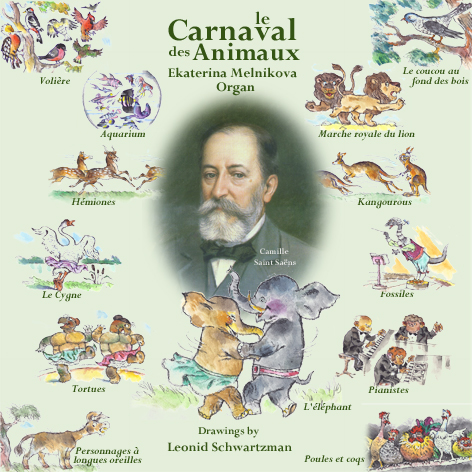|
\
|

After a concert tour of
Germany in 1885-86, Camille Saint-Saëns withdrew to a small
Austrian village, where he composed Le Carnaval des Animaux
in February 1886. He wanted to offer this lovely fancy of exquisite
music mingled with good-natured jokes as a surprise at the annual Shrove
Tuesday Concert.
From the beginning, Saint-Saëns regarded the work as a piece of fun. On
9 February 1886 he wrote to his publishers Durand in Paris that he was
composing a work for the coming Shrove Tuesday, and confessing that he
knew he should be working on his Third Symphony, but that this work was
"such fun" ("... mais c'est si amusant!"). He had apparently intended to
write the work for his students at the École Niedermeyer, but it was
first performed at a private concert given by the cellist Charles Lebouc
on Shrove Tuesday, 9 March 1886.
A second (private) performance was given on 2 April at the home of
Pauline Viardot with an audience including Franz Liszt, a friend of the
composer, who had expressed a wish to hear the work. There were other
private performances, typically for the French mid-Lent festival of Mi-Carême,
but Saint-Saëns was adamant that the work would not be published in his
lifetime, seeing it as detracting from his "serious" composer image. He
relented only for the famous cello solo The Swan, which forms the
penultimate movement of the work, and which was published in 1887 in an
arrangement by the composer for cello and solo piano (the original uses
two pianos).
Saint-Saëns did specify in his will that the work should be published
posthumously. Following his death in December 1921, the work was
published by Durand in Paris in April 1922 and the first public
performance was given on 25 February 1922 by Concerts Colonne (the
orchestra of Édouard Colonne).
Carnaval... has since become one of Saint-Saëns's best-known
works, played by the original eleven instrumentalists, or more often
with the full string section of an orchestra. Normally a glockenspiel
substitutes for the rare glass harmonica. Ever popular with music
teachers and young children, it is often recorded in combination with
Prokofiev's Peter and the Wolf or Britten's The Young Person's Guide to
the Orchestra.
 |
Ekaterina Melnikova
As International Concert Organist and Composer Ekaterina is
the rarest of musicians - performing on an instrument not
noted for its popularity, she manages, season after season,
to keep audiences on the edge of their seats in the finest
concert halls of Russia, Europe and around the world.
Ekaterina Melnikova is unusual in Russia for her mastery of
the English, French and Russian traditions of organ music.
Having received the finest education in two of the world’s
most prestigious music schools, the Moscow Conservatory and
London’s Royal Academy of Music,. She is a sought-after
guest at Westminster Abbey and St. Paul’s Cathedral in
London, La Trinité and Notre Dame in Paris, Cologne and
Monaco cathedrals and other celebrated concert venues in
Russia, Germany, France, Italy, Switzerland, Spain and
elsewhere. |
Ms.
Melnikova’s transcriptions for organ Le Carnaval des Animaux by
C.Saint-Saens, Polovtzian Dances from Prince Igor by A.P.Borodin and
Barber of Seville Sinfonia by G.Rossini have been published by Wayne
Leopold Editions, North Carolina, USA. Among her many compositions
are Missa XXI for SATB choir and organ, Beethoven-Tango for organ
and double basse and Toccata Freeway for organ solo.
In Ekaterina’s own words: “I simply adore the Grande Fantasie
Zoologique, as Camille Saint-Saens called Le Carnaval des Animaux.
The composer wanted it played only posthumously, not to shadow a bit
his glory of a serious composer. Why? Well, an attentive listener
will recognize fragments of the tunes popular at the time - last
half of the XIXth century - wittingly interwoven into the music. The
elephant double bass is gracefully waltzing the Ballet de Silphes
from Berlioz’s La Damnation de Faust and the tortoises are in fact
dancing in their own way to Offenbach’s Can-Can.
The joke of the genius was picked up by another extraordinary
artist, the XXth century cartoonist whose little monkey, and kitten
Gav, and Cheburashka and Crocodile Gena…and many other characters
have been admired by many generations in my country. Leonid
Schwartzman, responded promptly to the idea of illustrations to Le
Carnaval..., and the sketches came out embracing very naturally
Saint-Saens’s contemporary ironic allusions and adding a spark of
laughter from the new times!... Any similarities of facial
expressions of animals to those of well-known musicians are
incidental, or… well, in any case - made with love!”
|
Leonid
Schwartzman
or “Liolly” (his nick name), is the formidable
artistic creator of the cartoon drawings of Le
Carnaval des Animaux. He was born August 30, 1920
and is the legendary Russian classic of animation, the
creator of a visual image of Cheburashka and
other cartoon characters.
Artistic director of such publicly favourite cartoons like
The Scarlet Flower, Golden antelope, The Snow Queen,
Varezhka cycles cartoon Cheburashka and
Crocodile Gena. Kitten named Bow and 38
Parrots, directed by cartoons Garland of the
kids, Gullible dragon, a film from the series
Beware of Monkeys and many others. In Liolly’s own
words: «This music gives a lot of freedom to the imagination
of the artist, it portrays animals – and musicians! – in
amusing situations. It is full of humor and a pleasure to
illustrate.» |
 |
|
|



